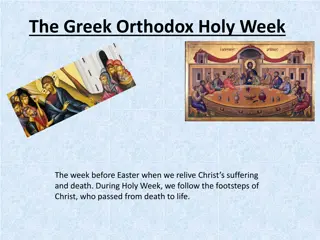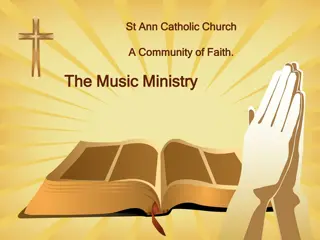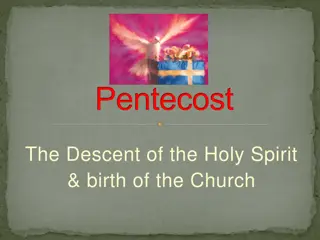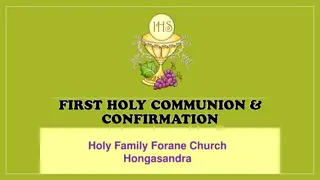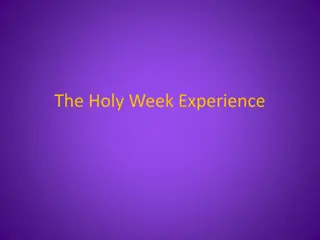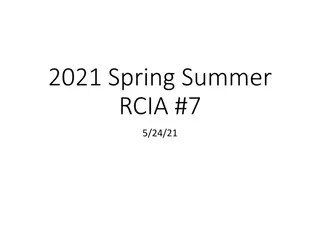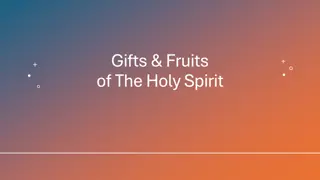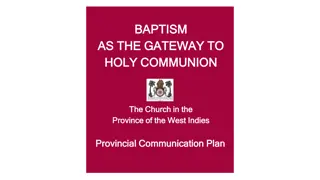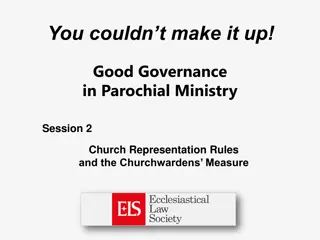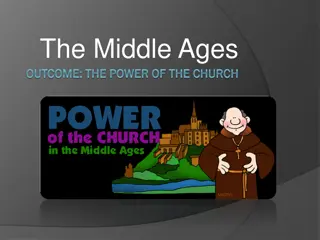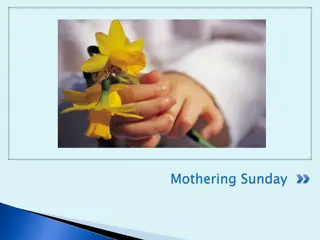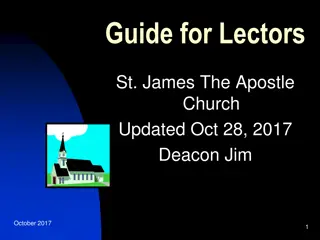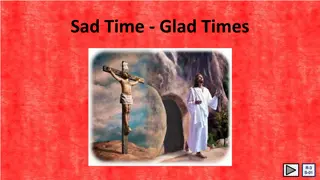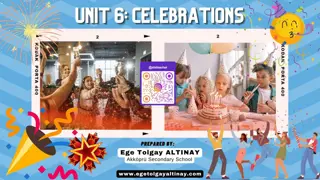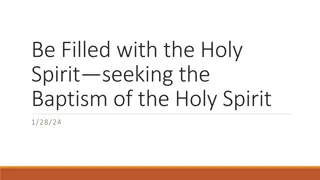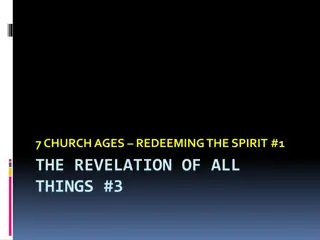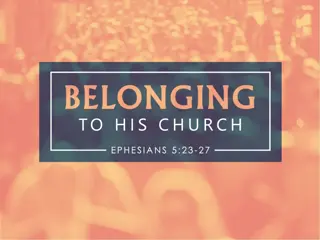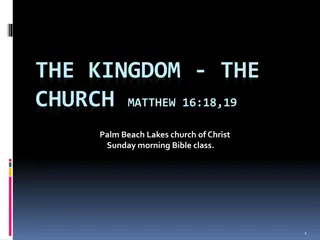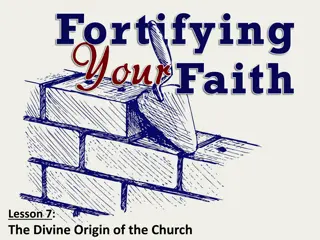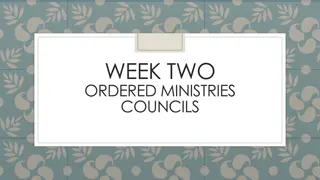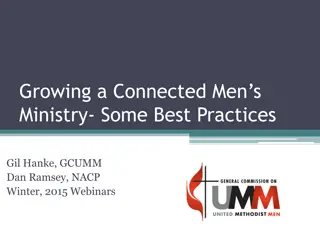Understanding Holy Thursday Celebrations in the Church
Explore the significance of Holy Thursday in the church, connecting the themes of the liturgy, reenactments of the Last Supper, and the relationship between the Jewish Passover Meal and the Christian Mass. Dive into the readings, learning intentions, and visuals to deepen your understanding of this important holy day.
Download Presentation

Please find below an Image/Link to download the presentation.
The content on the website is provided AS IS for your information and personal use only. It may not be sold, licensed, or shared on other websites without obtaining consent from the author. Download presentation by click this link. If you encounter any issues during the download, it is possible that the publisher has removed the file from their server.
E N D
Presentation Transcript
The Church celebrates Holy Thursday R-2 S-01
Learning Intentions The children will: 1) identify the themes of the readings in the Liturgy of the Word of the evening celebration of the Eucharist on Holy Thursday 2) identify how the commands in each of the Holy Thursday readings are fulfilled by the people today. R-2 S-02 Click in each caption space to reveal text
What I know already about how the Church celebrates Holy Thursday R-2 S-03 Click on the worksheet button to go to the worksheet
The Holy Thursday Liturgy recalls and celebrates the actual events by re-enacting them and making them real for the community Look closely at the 4 images. Write what you see and how the images on the left relate to those on the right. Explain how re-enacting the actual events of the Last Supper makes them real and present for you and the community. R-2 S-04
The First Reading at the Holy Thursday Mass tells about how the Passover Meal was to be celebrated A Reading from the book of Exodus 12:1-8, 11:14 God said to Moses and Aaron in the land of Egypt: Tell the people of Israel they are to take a lamb for each family. The lamb is to be killed at twilight. Some of the blood of the lamb is to be put on the doorpost of the house. They are to eat the lamb that same night. They are to eat it roasted over the fire with unleavened bread and bitter herbs. When you eat it you must be dressed ready to move on with sandals on your feet and a stick in your hand. You are to eat it quickly. It is the Passover of the Lord. When I see the blood on your door posts I will pass over you and protect you when I strike the land of Egypt. Keep remembering this day by celebrating the Passover meal. You must do it every year. When your children ask what this means, explain to them that this is God s Passover feast, when God passed over you and the firstborn of the Egyptians was killed. R-2 S-05 Click on the green button to advance through the lines.
Making connections between the Jewish Passover Meal and the Christian Mass The Mass is not simply a remembrance of Christ s paschal mystery, it is not a new sacrifice made every Sunday, but a sacrament in which his present-day followers sit around the table with making Christ s sacrifice present. foundation of the Catholic meal. love and thus commit Watch the clip and when it is finished make a list of the similarities between the Seder meal, the Last Supper and the Mass. him and participate in the event. Mass. themselves to living that love in their lives. While the Jewish and Christian Passovers are celebrations of different events, they share the Later when we have familiarised ourselves with the ritual of the Seder, we will see how Jesus departed from that ritual, we can understand the importance used several Passover Both Christians and Jews The concept of the Jewish Passover being made present should be familiar to Catholics. When they participate in the celebration of the Eucharist they are of his words and deeds that evening which became the themes at his final celebrate God s saving Regardless of whether the Last Supper was a Seder or not, Jesus same important meaning. R-2 S-06 Click top card to discard it. Click the video button to play the video: The Jewish Seder, The Last Supper and the Catholic Mass .
The Second Reading at the Holy Thursday Mass A Reading from 1 Corinthians 11:23-26 On the night when Jesus was betrayed he took a loaf of bread and when he had given thanks, he broke it and said, This is my body which is given up for you. Do this and remember me. In the same way he took the cup and said, This is the new covenant in my blood. Do this in remembrance of me. When you eat this bread and drink this cup you proclaim the Lord s death until he comes again. R-2 S-07A Click on the green button to advance through the lines. Click on the pen tool at the bottom left, then select the highlighter tool and use it to highlight any text.
The Second Reading at the Holy Thursday Mass 1) This passage from St Paul describes the first time Jesus changed the bread and wine into his body and blood. 2) This happened at the Last Supper Jesus had with his friends and is continued with his friends today in the Mass. 3) When Jesus did this he gave the disciples and all the priests that follow on from them the power to do this also. his friends and is continued with his friends today in the Mass. priests that follow on from them the power to do this also. Jesus changed the bread and wine into his body and blood. R-2 S-07B Click on the statement in the box that will complete the sentence correctly.
The Second Reading at the Holy Thursday Mass 4) Every time we go to Mass the priest repeats this action so we can remember Jesus as he asked us to at the Last Supper. 5) This action is called the Consecration of the bread and wine and Jesus gave priests the power to consecrate the bread and wine also. 6) When we are present at Mass we participate just as if we are present with Jesus and the disciples at the Last Supper. so we can remember Jesus as he asked us to at the Last Supper. present with Jesus and the disciples at the Last Supper. and Jesus gave priests the power to consecrate the bread and wine also. R-2 S-07C Click on the statement in the box that will complete the sentence correctly.
The Gospel in the Holy Thursday Liturgy Peter: Lord are you going to wash my feet? Jesus: You do not understand what I am doing now, but later you will . Peter: I will never let you wash my feet. Jesus: If I don t wash your feet it means you want nothing more to do with me. Peter: If that s what it means then wash my hands and my head too! Listen to the Gospel reading for Holy Thursday John 13:3-15 The Narrator reads the main part of the text. Class join in the words of Jesus and Peter. Narrator indicates when the class reads the words on the screen. Jesus: Do you know what I have done to you? You called me Lord and Teacher and that is right, for that is what I am. So if I, your Lord and Teacher, have washed your feet you should wash one another s feet. I have done this as an example so that you will do as I have done. R-2 S-08
What is the meaning of the washing of the feet? Watch the clip then read the message on the sub- titles that Pope Francis is speaking in Italian. It is the same message Jesus was giving to his apostles on the first Holy Thursday. What is it? What is washing someone s feet a symbol of? What else could children of your age do to develop an attitude of humility and service? Arrange to have a foot washing ceremony in your class. During it explain how this very old custom was carried out by the servants of the house. Think about how you could be of humble service at home and at school. Click the symbols to reveal text. Click the video button to play the video: Pope Francis washes prisoners' feet . R-2 S-09
How the instructions in the Readings for the Holy Thursday Mass are fulfilled today -Look at the picture of the priest washing the girl s feet. -Try to recall the instructions Jesus gave to the disciples about this. -Refer to the Gospel Reading - John 13:3-15 -How are these instructions being fulfilled by Christians today? -Can you identify which themes go with each reading freedom, service, remembrance, family, sharing, showing example, keeping instructions, friendship, symbols, recognising meaning, love, sacrifice, making present. -Look at the picture of the priest and the children. -Try to recall the instructions Jesus gave at the Last Supper. -Refer to the second Reading - 1 Corinthians 11:23-26 -How are these instructions being fulfilled by these people today? -Look at the picture of the Jewish family at their Seder Meal. -Try to recall the instructions God gave Moses and Aaron to prepare for the meal. -Refer to the first Reading - Exodus 12:1- 8, 11-14 if you need to. -How are these instructions being fulfilled today? R-2 S-10 Click an image to reveal text.
Setting Examples for People to Follow R-2 S-11 Click the pins on the right to reveal post-it notes.
Check Up 1) Write a paragraph about one of the readings, explain what it is about and why it was chosen for the Holy Thursday Mass. 2) Name some of the themes in one of the readings and describe how people make this reading present today in liturgy. 3) Make a picture of a Seder meal and write 3 things you learned about what it celebrates. R-2 S-12A
Check Up 4) Make an Acrostic for the word SERVICE refer to Overview for instructions. Use the Acrostic in the Sharing our Learning on Slide 12, R3. Which activity do you think helped you to learn best in this resource? 5) 6) Questions I would like to ask about the topics in this resource are R-2 S-12B Click on the worksheet button to go to the worksheet
Time for Reflection R-2 S-13 Click the audio button to stop reflective music Click the audio button to play reflective music



